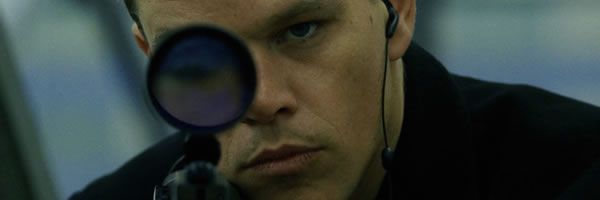The Bourne franchise is at a crossroads. Does the success of each movie depend on Matt Damon, or can Universal turn Bourne into Bond, an evergreen series that rotates in fresh blood every few movies? To explore that question, I tried to capture how the series has evolved over the last decade with Bourne by the Numbers. The feature provides a numbers-based snapshot of each movie and its place in the filmography by looking at the box office, critical reception, and miscellaneous facts.Hit the jump for a comprehensive review of the Bourne movies, featuring The Bourne Identity, The Bourne Supremacy, The Bourne Ultimatum, and The Bourne Legacy. 
The Bourne Identity
Year: 2002
RT: 83%
Worldwide Gross: $214 million
- 1980 – Year that the Robert Ludlum novel The Bourne Identity was published. Ludlum went on to write The Bourne Supremacy (1986) and The Bourne Ultimatum (1990). Eric Van Lustbader has continued the series with seven (and counting) additional novels after Ludlum died in 2001.
- 1988 – Year The Bourne Identity was first adapted into a telefilm. Richard Chamberlain played Jason Bourne in this four-hour version of the story that aired over two nights on ABC.
- 5 – Years director Doug Liman spent pushing his adaptation through development. It took two years to fully secure the film rights to the book from Warner Bros., another year to work on the script with Tony Gilroy, and two more years of production.
- 3 – Months Matt Damon spent training in stunt work, weaponry, boxing, and Kali (a martial arts discipline). Liman initially met with more traditional action leads like Sylvester Stallone and Russell Crowe, but chose Damon because the actor understood Liman’s take on the action genre.
- $8 million – Estimated cost overruns for the shoot that went two weeks longer than planned. The initial budget was $52 million, but the production hit a snag in France. Damon disliked some of the changes made to the script that he last approved, saying, “It became the exact kind of movie I would pass on, that I don’t want to do and that I avoided doing because there was the perfect number of explosions and everything.†Liman agreed enough to change the schedule on the fly. Gilroy started to fax new scenes from his office in New York to the European production headquarters during filming. Universal sent veteran producer Frank Marshall over to get things under control, and he recalls one sticking point: “I said, ‘Doug, we can't do the farmhouse scene. We're in downtown Paris. We don't have a farmhouse. It's not in the schedule.’†But Liman insisted because he believed the scene to be crucial in the characterization of Bourne. Marshall eventually called the studio and wrangled a bit more time and money for Liman. Still, Liman has referred to the experience as a “fucking nightmare†and later claimed, “Universal hated me. I had an archenemy in the studio. They were trying to shut me down. The producers were bad guys.â€
- 9 – Months the release date was delayed. Universal first announced a September 2001 release date before pushing it back to February 2002. A test audience wanted more action at the end of the movie, so Liman and Co. returned to Paris to shoot the climactic shoot-out. This required the studio to push The Bourne Identity back to May before eventually settling on June 14, 2002.
In retrospect, it seems miraculous that not only did The Bourne Identity overcome countless production obstacles, it kicked off a billion dollar franchise. Damon noted, “The word on Bourne was that it was supposed to be a turkey. It's very rare that a movie comes out a year late, has four rounds of reshoots, and it's good.†Although a solid effort, the Bourne franchise did not reach its peak until Paul Greengrass took the reins for the two sequels.
The Bourne Supremacy
Year: 2004
RT: 81%
Worldwide Gross: $289 million
- 12 – Months after the release of The Bourne Identity that Universal announced Damon would return for a sequel. Understandably, Liman did not join him. Gilroy suggested director Paul Greengrass to the producers---Greengrass earned the job on the strength of his depiction of the shootings in Bloody Sunday. Producer Patrick noted, “His sense of the camera as participatory viewer really suited the continuation of Jason's story.â€
- $3 million – Gilroy’s fee to return to write Supremacy. Liman made Gilroy miserable working on The Bourne Identity with endless demands for rewrites which Liman constantly reshot. Gilroy suggested Liman “didn’t have any sense of story, or cause and effect.†Gilroy was lured back in to write The Bourne Supremacy with a $3 million paycheck, the promise of a new director, and the pursuit of a story where Bourne repented for his crimes. Greengrass also managed to offend Gilroy by omitting this atonement. Gilroy fumed, “It was sort of like a crime against the gods of storytelling.â€
- 6 – Months of preparation to shoot for two weeks in India. Crowley explains why the location was worth it: “Of the places in the world where you could go and hide, it just seemed to be a place where you could blend in. We talked about China, we talked about other places, but one of the cool things about Goa was there are a lot of young tourists, which makes it perfect for Jason and Marie---they don't stick out.â€
- 2 – Times Damon ruined the take while shooting the car crash sequence. Damon claims he “blew the first two takes, because I was having such a blast that I was smiling and yelling the whole time.â€
- 2.4 – Average shot length in seconds. That translates to over 2500 edits over the course of the 108-minute runtime. (For comparison, the similarly quick Bourne Identity kept the average shot length around 4 seconds.) By taking it to the extreme, Greengrass helped establish a precedent for the rapid-fire shaky camera that many action movies have since adopted.
- 90 – Seconds needed to track Bourne’s position when he calls Pamela Landy (Joan Allen). Bourne disconnects the call in exactly 88 on-screen seconds.
The Bourne Supremacy works great as a proof of concept: the Bourne mythology can carry these spy stories beyond the one movie, marked by killing off a major character in the first act that launches Bourne on a mission of vengeance. Greengrass takes the action to the next level, too. The Knife vs. Magazine fight is a brutal, beautiful piece of filmmaking.
The Bourne Ultimatum
Year: 2007
RT: 94%
Worldwide Gross: $443 million
- 7 – Countries in which the movie was shot, spanning 3 continents. Locations included Tangier, London, Paris, Madrid, Berlin, New York, and other cities in the U.S. The production made use of local crews, so that more than 250 people ended up working behind the camera.
- 35 – Speed limit in miles per hour on all vehicles used to shoot the climactic car chase in Manhattan. The NYPD set this limit out of concern for public safety. The production spent six week orchestrating and shooting the scene.
- $69.2 million – Opening weekend box office gross. The Bourne Ultimatum still holds the record for the highest opening weekend in August. Ultimatum should remain the highest-grossing Bourne movie unless The Bourne Legacy exceeds expectations.
- 3 – Academy Awards and wins. The Bourne Ultimatum won Oscars for Best Film Editing, Best Sound Mixing, and Best Sound Editing.
- 0 – Times Gilroy watched the movie after it was released. Universal brought back Gilroy once more with another big paycheck for The Bourne Ultimatum, which he agreed to on the condition that he did not have to speak with Greengrass. Gilroy wrote a draft, then promptly left the project, and claimed he had not seen the finished product as of 2009. (The Bourne Legacy is deeply intertwined with the plot of The Bourne Ultimatum, so I imagine Gilroy has now seen Ultimatum.) Damon later laid into Gilroy’s pass at the script: “I don't blame Tony for taking a boatload of money and handing in what he handed in. It's just that it was unreadable. This is a career-ender. I mean, I could put this thing up on eBay and it would be game over for that dude.†Damon later apologized for the “kind of douchey†move of saying such a thing publicly, and Gilroy seemed to be cool with it.
The series reached delirious heights here: unanimous acclaim, nearly $500 million, and three Oscars. I can understand why Greengrass and Damon were hesitant to try to follow this. The chase across the roofs of Tangier has become the signature scene of the series---why try to top it? I hope Damon eventually does come back for one more (and maybe even teams up with Renner), but I won’t hold my breath.
The Bourne Legacy
Year: 2012
RT: 52%
Worldwide Gross: TBD
- 2008 – Year when Universal announced that Damon and Greengrass were on board for a fourth Bourne movie. That came as a surprise since Damon, prior to the release of The Bourne Ultimatum, indicated that he was not interested in a sequel: “We have ridden that horse as far as we can.â€
- 5 – Number of years Damon, in 2010, said he expected to pass in before he returned to the character. But he did not believe the franchise would lay dormant: “There’ll probably be a prequel of some kind with another actor and another director before we do another one, just because I think we’re probably another five years away from doing it. We’ve got to get a script.†Damon’s stance now is that he is absolutely willing to play Jason Bourne again as long as Greengrass returns. In the meantime, Gilroy overcame the bitterness associated with the franchise and signed on to direct The Bourne Legacy, which would center around a new spy.
- 14 – Names we heard tested for the lead role as the new star of The Bourne Legacy. The list included Jake Gyllenhaal, Tobey Maguire, Taylor Kitsch, Michael Fassbender, and many more. They eventually landed on Jeremy Renner to play Aaron Cross, another government-engineered super agent.
- 15 – Oscar nominations among the cast. Renner (2), Edward Norton (2), Rachel Weisz (1), Albert Finney (5), David Strathairn (1), Joan Allen (3), and one more from (highlight for possible spoiler) {Chris Cooper}.
- 4 – People standing by on the set in Canada to prevent hypothermia. Our introduction to Cross sees him submerged in an icy lake. Renner shot the scene where he emerges shirtless from the lake in below freezing temperatures. Renner explained, “Cold is cold. If it’s 39 or 29, it doesn’t matter.†They got it in one take.
- 3.5 – Stories of “the chasm.†In the trailer you can see Cross sliding down a small gap between buildings to land on a bad guy. That gap was 3 and a half stories high and only two feet wide. The crew used one existing wall from a Manila building and constructed the wall next to it. Rather than aging the wall artificially, they bought old siding from local homes and installed new walls on the houses they stripped.
- 90 – Cars used in the Manila chase sequence. More than 300 extras were employed---the scene shot on a mile-and-a-half stretch of road through three major intersections over several weekends. Crowley admitted, “Manila’s a tough city to work in: There are traffic jams, and it’s hard to move around.†He continued, “But the people are so gracious and excited about films. They know more about the Bourne movies than I know about the Bourne movies.â€
- $130 million – Listed production budget. This makes The Bourne Legacy the most expensive Bourne movie yet.
- 135 – Runtime in minutes. The Bourne Legacy is the longest in the series, 16 minutes longer than The Bourne Identity.
I return to my opening question: Does the success of each movie depend on Damon, or can Universal turn Bourne into Bond, an evergreen series that rotates in fresh blood every few movies? I think Gilroy and Renner make a great case for the latter in The Bourne Legacy, establishing a character that carves out his own identity in the Bourne universe while justifying further exploration in a sequel or two.
For my money, the MVP of The Bourne Legacy is production designer Kevin Thompson, whom Gilroy has worked with in all his directorial features. The major locations are spectacular, and the geography and personality of the sets are integrated so well into the storytelling. Sure, it’s hard to screw up the scenes set on a snowy mountain or amid the streets of Manila. But my favorite set is the rundown house in the woods. The action covers every inch---inside and out---of that house, all of it resourcefully choreographed to find the true cinematic purpose of each room. The runner-up is the beyond-tense depiction of a shootout in the science lab. It is terrifying to witness the gunman discreetly seal off every possible exit, and exhilarating to see Marta (Weisz) save herself by ducking into all the right corners of the lab at the right time. The great set pieces do not add up to a greater whole, a chain of action that escalates and builds to the climax. But I am okay with that since most of these scenes, judged on their own merits, engage as they progress the story.
The Bourne Legacy works best as a contained thriller, as in the house and the lab. So when we expand to the big chase through Manila, it appeals to the visual senses but only makes a superficial connection---it’s the closest Legacy comes to mindless action. Part of the problem is the last-minute introduction of a new foe for Cross to fight. He is nondescript, and essentially one last video game boss for Cross to defeat. It feels like he should have been introduced earlier in the story, or removed to involve the Eric Byer (the villainous government puppet master played by Norton) more directly in the final act.
Weisz is responsible for the scientific explanation of what’s going on, while Norton gets most of the political exposition. It is mostly technical gibberish that is used to develop the characters (Weisz’s scientist is terrible at dumbing down the explanation, as most real-life virologists would be), but the story is effectively conveyed in other ways. Cross is dependent on Outcome-issued pills, or “chems.†The blue one makes him smart, the green one enhances his physical abilities. There is a ticking clock because the tin that hangs around his neck is nearly empty. (He resorts to licking the dust of the last pill.) In the meantime, Outcome needs to destroy any evidence that it ever existed to avoid a public PR disaster. To do so they issue all Outcome agents yellow triangular pills that cause mortal nosebleeds, and spend the rest of the movie trying to finish the job with Cross and Marta. Honestly, primary colors tell half the story. Another great example of simple visual storytelling: Byer is tracking Cross on radar. Cross straps a metal plate to his right hip and the signal disappears. How does that work? Later, we see Cross cut out the tracking device from his midsection just above the right hip.
The Bourne Legacy is not without its flaws, but when it’s good, it’s really good. Casting Renner as the new star was a smart choice---he delivers such a capable performance as the action lead that his Aaron Cross could grow to the stature of Jason Bourne over time if Legacy does well enough to merit a sequel. I am rooting for this, because I would love to see another version of The Bourne Legacy with a few of the kinks worked out.
—
Unless otherwise linked, all information comes from Wikipedia or IMDB.
If you liked this, check out Pixar by the Numbers and Batman by the Numbers.




